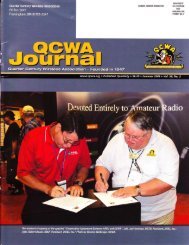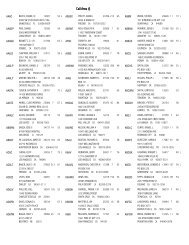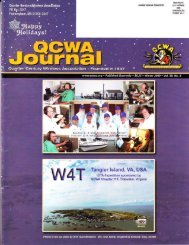G[mloulnal - Quarter Century Wireless Association
G[mloulnal - Quarter Century Wireless Association
G[mloulnal - Quarter Century Wireless Association
Create successful ePaper yourself
Turn your PDF publications into a flip-book with our unique Google optimized e-Paper software.
PART 1<br />
This story starts in the early days of a young ham in the late<br />
1950's when, to get started in the hobby, one only had to pass a<br />
1 2 w p m code test taken by the local postmaster. In those days a<br />
popular way of getting on the air with limited financial resources<br />
was by converting war surplus radios. Surplus military equipment<br />
could be found in abundance at the time at various outlets<br />
in the major cities for next to nothing. There were iiteraily heaps<br />
ofstuffto search through at your hearts content. Experts in converting<br />
surplus gear and help to convert what ever you may have<br />
acquired were just a matter of asking. Ideas to put these pieces of<br />
equipment to ham use were ingenious, like the Command receiver<br />
with plug in bank of coils<br />
at the bottom. The companion<br />
Command transmirrers covering<br />
3,5 to 4 MHz formed a highly<br />
stable VFO which could be<br />
doubled ro the higher, harmonically<br />
related amateur bands.<br />
One of my ham teachers<br />
those days was Jack Snyman,<br />
ZS1OU of the Strand. Both he<br />
and his wife, Marge, ZSIRM,<br />
were very keen and good C\7<br />
operators and they had a shack<br />
that was the enr,y of every ham<br />
that walked in, sporting a Collins<br />
S-line, rhe absolure ulrimate in<br />
those days. From Stellenbosch, I<br />
could hear their signals on backscatter<br />
good enough to have<br />
many C\W QSOs at times when<br />
DX was fading. Their sryle of code sending was outstanding in<br />
rhythm, clarity and readabiliq,. I always tried to emulate their<br />
perfection, even though only using converted surplus equipment,<br />
home made bug and a single feed line'i(indom wire antenna.<br />
Whenever I visited Jack, his invitation to listen around a bit<br />
on the Collins was never declined and on more occasions than<br />
one I am sure my weicome must have been exceeded by far. The<br />
light amber backlit dials of the Collins transmitter and receiver<br />
had thin black lined fiduciaries that had to be carefully set up on<br />
each band, using the calibration oscillator. Tirrning the turning<br />
dials felt like stoking a piece of velvet. Audio coming from the<br />
oval ioudspeaker in the matching power supply was crisp and<br />
fully rounded and the background noise was just a pleasant<br />
crackle, enough to remind one that the rig was alive. "This was<br />
what I wanted - - one day when I grow up." After finishing studies<br />
and leaving the area to take up a position in Johannesburg,<br />
contact with Jack over many years was maintained by regular<br />
CW chats and the occasional personal visit when an opportuniry<br />
presented itself. But, as with ail of us mortal beings, the years<br />
started to take it's toll and I sadly saw my friend and mentor fade<br />
due to terminal cancer. He had an exceptionally good memory<br />
and enjoyed recalling and talking about the good times he and<br />
Marge had on the air in great detail even at a late stage of his<br />
illness. Thanks to modern medication he never suffered so bad<br />
that he did not feel like operating his station. My last QSO with<br />
Now Vidi is the owner of the Collins gedr he so much<br />
admired in his youth.<br />
44 QCWA fournal - Summer 2001<br />
him was in June 1999 and my last personal visit to Jack was in<br />
March 2000. At that time he had the 755-3 receiver and 325-3<br />
transmitter out of their cabinets and the cabinets neatly wrapped<br />
in plastic to preserve them. What is more, he believed that providing<br />
extra air circulation would prolong the life of the 26 odd<br />
tubes..... and of course to see them glow in the dark is something<br />
special. Unfortunately the chemotherapy and radiation treatment<br />
caused trembling of his hands and affected his CW sending to<br />
such an extent that it was difficult to recognize that once musical<br />
rhythm of his 30 wpm code. Spacing between letters and words<br />
became vague and at occasions anticipation had to be used to<br />
understand what he was trying to say. After several months of<br />
not hearing him on the atr, news<br />
came about problems he had with<br />
the S-iine. He was asking for heip<br />
and needed rectifier tubes for the<br />
transmitter power supply. News<br />
also reached me that he had to have<br />
the power transformer rewound.<br />
Apparently he never managed to<br />
get the station back on the air before<br />
his key sadly became silent on<br />
the 5th ofAug 2000.<br />
PART 2<br />
Based on fond memories of<br />
Jack, the respect and admiration I<br />
had for him as a young ham and<br />
the dream station he had, I decided<br />
to make an offer for the now<br />
crippied Collins S-line. The offer<br />
was accepted by the family and<br />
plans had to be made to collect the<br />
equipment in Somerset'!(est. As it happened, an opportuniry to<br />
house sit for reiatives in Somerset West suddenly appeared out of<br />
the blue and the Collins expedition was on. My wife Hester,<br />
ZS5ESU and I selected some very bare essentials for the expedition<br />
in the line of tools, including a soldering iron, multi meter<br />
and RF power meter so that we couid set up a small workshop in<br />
the lower level of the large house we had to watch over for a<br />
month. I collected the 37-year-old station together with the 'instruction<br />
books which had fold out circuit diagrams of more than<br />
1m long, falling apart in various places and heid together with<br />
yellowing tape. The diagrams were speckled with hand written<br />
notes. Some were in pencil and others in red, blue and black<br />
ballpoint pen ofvoltages and resistance measurements. There were<br />
many circles drawn around suspect components with question<br />
marks and notes beside them. I realized that the thousands of<br />
hours on the air did not go by unnoticed by our friend'wear and<br />
tear'. The emission switch on the transmitter was hard to turn<br />
and the front panel of both units had spots and blemishes but<br />
fortunately no scratches. The control knobs had faded yellowy<br />
index lines that used to be brilliant white and all the pilot lights<br />
were fused. The power suppiy had obviously been a major problem.<br />
There were no rectifier tubes and the wiring was very untidy<br />
and temporary. Jack obviously never got the rig back on the air<br />
after the transformer was rewound. This was the rig I once admired<br />
and now had to face the challenge of getting it to, or close



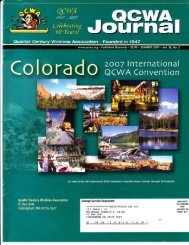
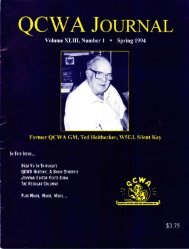
![11{J hI EfifSIt]E I]E - Quarter Century Wireless Association](https://img.yumpu.com/11816560/1/190x245/11j-hi-efifsite-ie-quarter-century-wireless-association.jpg?quality=85)
